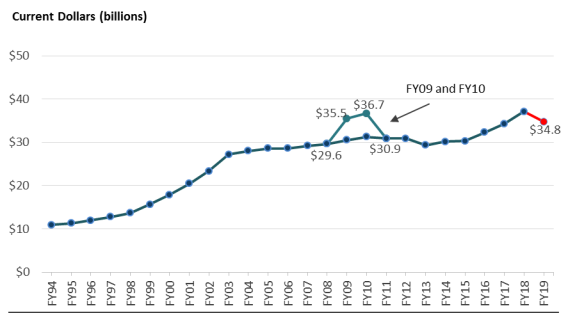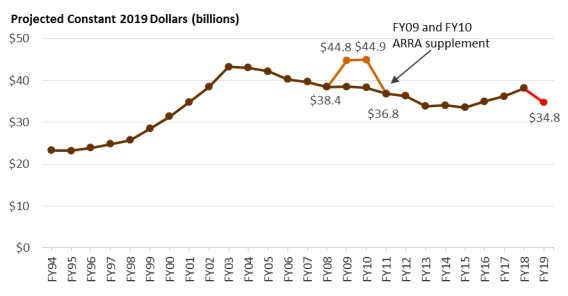NIH Funding: FY1994-FY2019
The National Institutes of Health (NIH) is the primary federal agency charged with conducting and supporting biomedical and behavioral research. It is the largest of the eight health-related agencies that make up the Public Health Service (PHS) within the Department of Health and Human Services (HHS).1 NIH's organization consists of the Office of the Director (OD) and 27 Institutes and Centers. The OD sets overall policy for NIH and coordinates the programs and activities of all NIH components, particularly in areas of research that involve multiple institutes.
NIH activities cover a wide range of basic, clinical, and translational research, focused on particular diseases, areas of human health and development, or more fundamental aspects of biomedical research. Its mission also includes research training and health information collection and dissemination.2 More than 80% of the NIH budget funds extramural research through grants, contracts, and other awards.3 This funding supports research performed by more than 300,000 individuals who work at over 2,500 hospitals, medical schools, universities, and other research institutions around the country.4 About 10% of the agency's budget supports intramural clinical and basic research conducted by nearly 6,000 NIH physicians and scientists, most of whom are located on the NIH campus in Bethesda, MD.5
Funding for NIH comes primarily from the annual Labor, HHS, and Education (LHHS) appropriations bill, with an additional amount for Superfund-related activities from the Interior/Environment appropriations bill. Those two bills provide NIH's discretionary budget authority.6 In addition, NIH receives mandatory funding of $150 million annually that is provided in the PHS Act for a special program on type 1 diabetes research and funding from a PHS Act transfer. The total funding available for NIH activities, taking account of add-ons and transfers, is known as the NIH program level.
Table 1 outlines NIH program level funding over the past 25 years, and Figure 1 illustrates funding trends in both current (also called nominal dollars) and projected constant (i.e., inflation-adjusted) 2019 dollars. Between FY1994 and FY1998, funding for NIH grew from $11.0 billion to $13.7 billion in nominal terms. Over the next five years, Congress and the President doubled the NIH budget to $27.2 billion in FY2003. In each of these years, NIH received annual funding increases of 14% to 16%. Since FY2003, NIH funding has increased more gradually in nominal dollars. Funding peaked in FY2010 before declining in FY2011 through FY2013, with increases in subsequent years.7 In some years, funding for the agency decreased in nominal dollars. For instance
- the FY2006 total was 0.1% lower than the previous year, the first time that the NIH appropriation had decreased since FY1970;
- the FY2011 total, provided in the Full-Year Continuing Appropriations Act, 2011 (P.L. 112-10), was 1.0% below the previous year; and
- the FY2013 total, provided in the Consolidated and Further Continuing Appropriations Act, 2013 (P.L. 113-6), was reduced by the March 2013 sequestration and a transfer of funding under the authority of the HHS Secretary ($1.553 billion and $173 million respectively), resulting in a budget that was 5.0% lower than the prior year.8
The NIH program level in FY2018 is $37.311 billion, which includes $77 million for Superfund-related research and the $150 million in diabetes research funding.9 The Consolidated Appropriations Act, 2018 (H.R. 1625, P.L. 115-141), provides $37.084 billion for NIH in Division H (the LHHS appropriations act); this amount includes $496 million for the NIH Innovation account (see text box) and $923 million from the evaluation tap.10 The FY2018 program level total represents an increase of $3.0 billion (+8.7%) from FY2017, making this the largest single-year nominal dollar increase since FY2003 (excluding one-time funds provided by the American Recovery and Reinvestment Act of 2009 [ARRA, P.L. 111-5]).
President Trump's FY2019 budget requests an NIH program level total of $34.767 billion, a decrease of $2.544 billion (-6.8%) compared with FY2018 enacted.11 One account, Buildings and Facilities, would receive a 55% increase in funding for FY2019 compared to FY2018, and OD would receive a smaller increase; all other accounts for the NIH Institutes and Centers would receive a decrease compared to FY2018. Note that final FY2018 appropriations had not been enacted during the period in which the FY2019 President's request was being formulated. While the total request for NIH represents a decrease from FY2018-enacted levels, it represents an increase from FY2017-enacted levels and the FY2018 continuing resolution levels that were in place at the time FY2019 request levels were being determined.
|
The 21st Century Cures Act and the NIH Innovation Account The 21st Century Cures Act (P.L. 114-255) created the NIH Innovation account and specified that funds in the account must be appropriated in order to be available for expenditure. The law authorized a total of $4.796 billion to be appropriated in the NIH Innovation account over a 10-year period, FY2017 through FY2026. The first round of funding was provided by Section 194 of the Further Continuing and Security Assistance Appropriations Act, 2017 (CR, P.L. 114-254). The CR appropriated $352 million, and the Consolidated Appropriations Act, FY2018 (H.R. 1625, P.L. 115-141), appropriated $496 million in the NIH Innovation account for necessary expenses to carry out the four NIH Innovation Projects as described in Section 1001(b)(4) of the Cures Act. The FY2019 total NIH budget request includes $711 million made available through the 21st Century Cures Act. The four projects authorized by the Cures Act are the Precision Medicine Initiative (FY2017, $40 million; FY2018, $100 million; FY2019, $186 million), the BRAIN Initiative (FY2017, $10 million; FY2018, $86 million; FY2019, $115 million), cancer research (FY2017, $300 million; FY2018, $300 million; FY2019, $400 million), and regenerative medicine using adult stem cells (FY2017, $2 million; FY2018, $10 million; FY2019, $10 million). Amounts, once appropriated, are to be available until expended. The NIH Director may transfer these amounts from the NIH Innovation account to other NIH accounts but only for the purposes specified in the Cures Act. If the NIH Director determines that the funds for any of the four Innovation Projects are not necessary, the amounts may be transferred back to the NIH Innovation account. This transfer authority is in addition to other transfer authorities provided by law. For further information, see CRS Report R44720, The 21st Century Cures Act (Division A of P.L. 114-255). |
The lower half of Figure 1 portrays NIH funding adjusted for inflation (in projected constant 2019 dollars) using the Biomedical Research and Development Price Index (BRDPI).12 It shows that the purchasing power of NIH funding (non-ARRA) peaked in FY2003 (the last year of the five-year doubling period) and then fairly steadily declined for more than a decade (excluding ARRA) until back-to-back funding increases were provided in FY2016, FY2017 and FY2018. In projected constant 2019 dollars, the FY2019 program level request for NIH is 19.5% less than the program level in FY2003.
|
Figure 1. National Institutes of Health (NIH) Funding, FY1994-FY2019 Request Program Level Funding in Current and Projected Constant (2019) Dollars |
 |
 |
|
Sources: NIH Budget Office, Appropriations History by Institute/Center (1938 to Present), at http://officeofbudget.od.nih.gov/approp_hist.html. FY2017 and FY2018 enacted amounts are from the Explanatory Statement on the Consolidated Appropriations Act, FY2018 (H.R. 1625, P.L. 115-141), in the March 22, 2018 Congressional Record, pp. H2681, H2733-H2735. FY2019 request amounts are from Department of Health and Human Services, Fiscal Year 2019 Budget in Brief, Washington, DC, February 2018, p. 40. Inflation adjustment reflects the Biomedical Research and Development Price Index (BRDPI), updated January 2018, https://officeofbudget.od.nih.gov/gbiPriceIndexes.html. Notes: Program level includes all budget authority including appropriations for the Global Fund to Fight AIDS, TB, and Malaria (FY2002-FY2011) that were subject to transfer-out. As of FY2012, NIH no longer receives appropriations for the National Institute of Allergy and Infectious Diseases (NIAID) identifying resources for the Global Fund; this responsibility was transferred to another federal agency. Totals include amounts "transferred in" pursuant to PHS Act transfer authority (evaluation tap), but do not exclude any amounts "transferred out" under this same authority. ARRA supplementary funding is from the American Recovery and Reinvestment Act of 2009, P.L. 111-5. In general, amounts provided to NIH for emergency requirements are excluded from these totals (e.g., FY2015 amount does not include $238,000,000 for the National Institute for Allergy and Infectious Diseases [NIAID] for research on Ebola that was provided in P.L. 113-235, Title VI of Division G). The FY2019 request level does not include NIH's proposed share ($750 million) of an additional $10 billion in HHS-wide opioid-related funding requested by the FY2019 President's budget. |
Table 1. NIH Funding, FY1994–FY2019 Request
Program Level Funding in Current and Constant (2019) Dollars (billions)
|
Fiscal Year |
Program Level |
% Change |
Program Level Projected Constant 2019 $ |
% Below 2003 |
|
1994 |
$10.956 |
23.228 |
||
|
1995 |
11.300 |
3.1% |
23.155 |
|
|
1996 |
11.928 |
5.6% |
23.832 |
|
|
1997 |
12.741 |
6.8% |
24.768 |
|
|
1998 |
13.675 |
7.3% |
25.712 |
|
|
1999 |
15.629 |
14.3% |
28.485 |
|
|
2000 |
17.841 |
14.1% |
31.347 |
|
|
2001 |
20.459 |
14.7% |
34.791 |
|
|
2002 |
23.321 |
14.0% |
38.387 |
|
|
2003 |
27.167 |
16.5% |
43.198 |
|
|
2004 |
28.037 |
3.2% |
42.980 |
-0.5% |
|
2005 |
28.594 |
2.0% |
42.194 |
-2.3% |
|
2006 |
28.560 |
-0.1% |
40.279 |
-6.8% |
|
2007 |
29.179 |
2.2% |
39.647 |
-8.2% |
|
2008 |
29.607 |
1.5% |
38.430 |
-11.0% |
|
2009 |
30.545 |
3.2% |
38.520 |
-10.8% |
|
2010 |
31.238 |
2.3% |
38.231 |
-11.5% |
|
2011 |
30.916 |
-1.0% |
36.785 |
-14.8% |
|
2012 |
30.861 |
-0.2% |
36.255 |
-16.1% |
|
2013 |
29.316 |
-5.0% |
33.806 |
-21.7% |
|
2014 |
30.143 |
2.8% |
34.029 |
-21.2% |
|
2015 |
30.311 |
0.6% |
33.536 |
-22.4% |
|
2016 |
32.311 |
6.6% |
34.989 |
-19.0% |
|
2017 |
34.311 |
6.2% |
36.212 |
-16.2% |
|
2018 |
37.311 |
8.7% |
38.349 |
-11.2% |
|
2019 request |
34.767 |
-6.8% |
34.767 |
-19.5% |
|
NIH Funding Including ARRA Supplement |
||||
|
2009 |
35.499 |
44.773 |
||
|
2010 |
36.684 |
44.902 |
||
Source: NIH Budget Office, Appropriations History by Institute/Center (1938 to Present), at http://officeofbudget.od.nih.gov/approp_hist.html. http://officeofbudget.od.nih.gov/approp_hist.html. FY2017 and FY2018 enacted amounts are from the Explanatory Statement on the Consolidated Appropriations Act, FY2018 (H.R. 1625, P.L. 115-141), in the March 22, 2018 Congressional Record, pp. H2681, H2733-H2735. FY2019 request amounts are from Department of Health and Human Services, Fiscal Year 2019 Budget in Brief, Washington, DC, February 2018, p. 40. Inflation adjustment reflects the Biomedical Research and Development Price Index (BRDPI), updated January 2018, https://officeofbudget.od.nih.gov/gbiPriceIndexes.html.
Notes: Amounts in table may differ from actuals in many cases. By convention, budget tables, such as Table 1 do not subtract the amount of PHS Act transfers from the agencies' funding. Program Level includes all budget authority, including appropriations for the Global Fund to Fight AIDS, TB, and Malaria (FY2002-FY2011) that were subject to transfer-out. As of FY2012, NIH no longer receives appropriations for the National Institute of Allergy and Infectious Diseases (NIAID) identifying resources for the Global Fund; this responsibility was transferred to another federal agency. ARRA supplementary funding is from the American Recovery and Reinvestment Act of 2009, P.L. 111-5. In general, amounts provided to NIH for emergency requirements are excluded from these totals (e.g., FY2015 amount does not include $238,000,000 for the National Institute for Allergy and Infectious Diseases [NIAI]) for research on Ebola that was provided in P.L. 113-235, Title VI of Division G.) The FY2019 request level does not include NIH's proposed share ($750 million) of an additional $10 billion in HHS-wide opioid-related funding requested by the FY2019 President's budget.